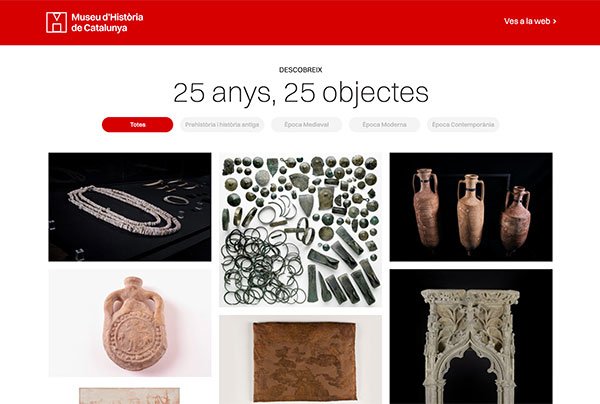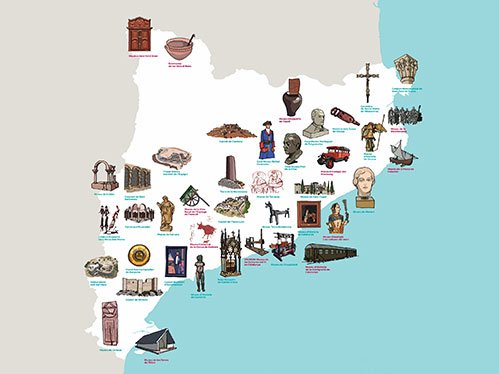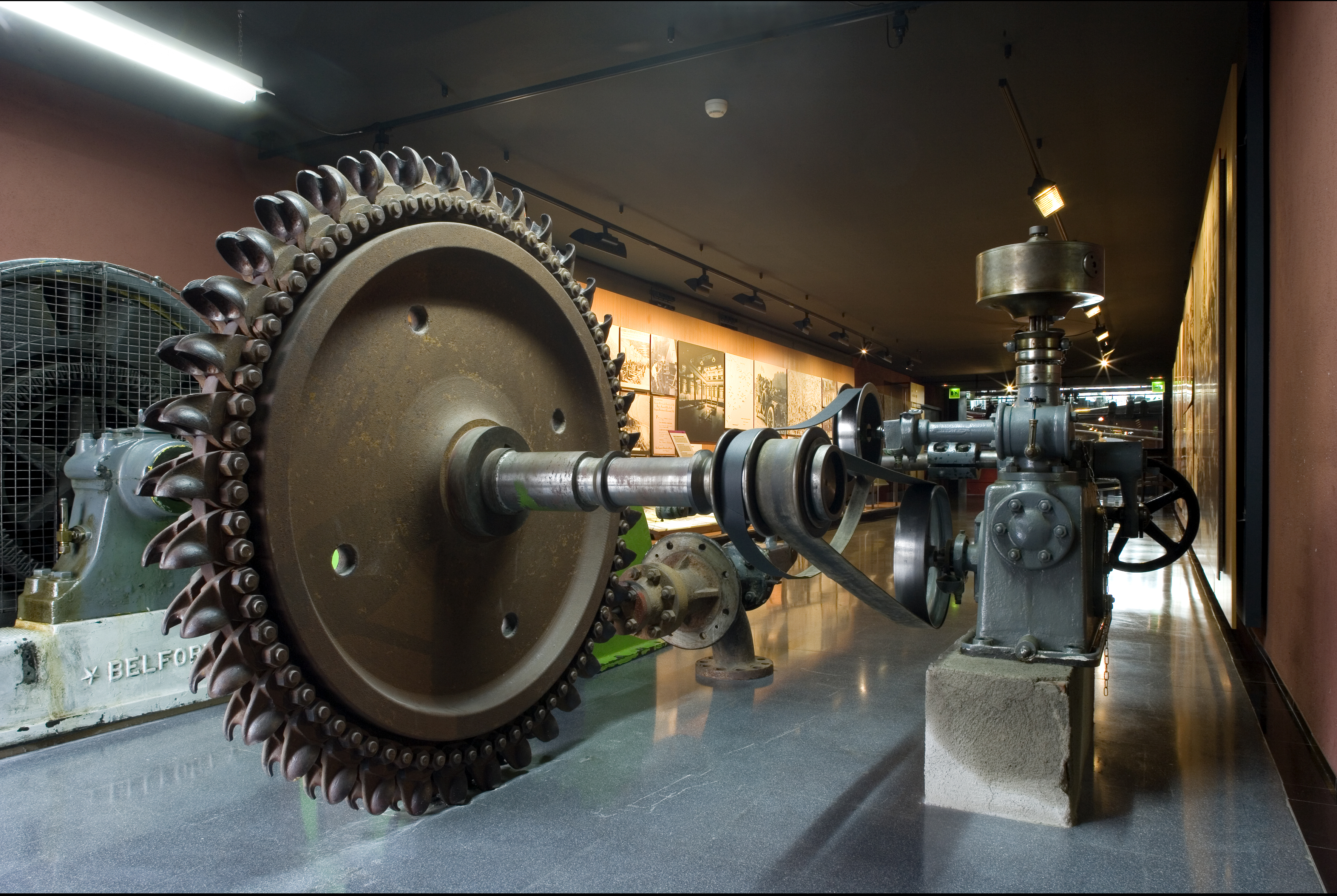Al canviar d'idioma no tots els continguts estan traduïts
The website is not fully translated
Al cambiar de idioma no todos los contenidos están traducidos
Al canviar d'idioma no tots els continguts estan traduïts
 Opening times
Opening times
 Location
Location
 Tickets
Tickets
 Admissions
Admissions
Opening times
Tuesday to Saturday, 10am to 7pm
Wednesdays, 10am to 8pm
Sundays and public holidays, 10am to 2.30pm
The ticket office and entrance are closed 30 minutes before closing time
CLOSED: Mondays that are not bank holidays, 1 and 6 January, 1 May, 18 May, 1 June, 25 and 26 December
Location
Address
Plaça de Pau Vila, 3
08039 Barcelona
Coordinates: 41.380900, 2.185693
Contact
932 254 700
mhc.cultura@gencat.cat
Fax 932 254 758
Group and school bookings:
932 254 244
Monday to Thursday: 10am-2pm and 3.30-5.30pm
Friday: 9.30am-2pm
mhcvisites.cultura@gencat.cat
Transport and access routes
Public transport
Buses V17, H14, D20, V15, V13, 39, 45, 51, 59 and 120
Metro L4 (yellow) Barceloneta
Train to Barcelona Estació de França
Barcelona Tourist Bus: red line; and Barcelona City Tour: eastern route; Museu d’Historia de Catalunya stop.
Parking
There are three paid-for car parks nearby: in Passeig Joan de Borbó, Moll d’Espanya and Moll de la Fusta.
Coaches have parking spaces available near the museum building.
“Bicing” bicycle hire in Plaça Pau Vila.
Admissions
Permanent exhibition
Temporary exhibitions
General admission: 4 euros
Reduced admission: 3 euros
Combined ticket
Permanent exhibition + temporary exhibition
General admission: 8 euros
Reduced admission: 6 euros
 Opening times
Opening times
 Location
Location
 Tickets
Tickets
 Admissions
Admissions
Opening times
Tuesday to Saturday, 10am to 7pm
Wednesdays, 10am to 8pm
Sundays and public holidays, 10am to 2.30pm
The ticket office and entrance are closed 30 minutes before closing time
CLOSED: Mondays that are not bank holidays, 1 and 6 January, 1 May, 18 May, 1 June, 25 and 26 December
Location
Address
Plaça de Pau Vila, 3
08039 Barcelona
Coordinates: 41.380900, 2.185693
Contact
932 254 700
mhc.cultura@gencat.cat
Fax 932 254 758
Group and school bookings:
932 254 244
Monday to Thursday: 10am-2pm and 3.30-5.30pm
Friday: 9.30am-2pm
mhcvisites.cultura@gencat.cat
Transport and access routes
Public transport
Buses V17, H14, D20, V15, V13, 39, 45, 51, 59 and 120
Metro L4 (yellow) Barceloneta
Train to Barcelona Estació de França
Barcelona Tourist Bus: red line; and Barcelona City Tour: eastern route; Museu d’Historia de Catalunya stop.
Parking
There are three paid-for car parks nearby: in Passeig Joan de Borbó, Moll d’Espanya and Moll de la Fusta.
Coaches have parking spaces available near the museum building.
“Bicing” bicycle hire in Plaça Pau Vila.
Admissions
Permanent exhibition
Temporary exhibitions
General admission: 4 euros
Reduced admission: 3 euros
Combined ticket
Permanent exhibition + temporary exhibition
General admission: 8 euros
Reduced admission: 6 euros
The electric years: 1900 to 1939
At the beginning of the 20th century, Catalonia was a restless country in political, economic, social and cultural terms. The crisis of the regime led to the rise of republicanism and political Catalan nationalist movements, which obtained a great victory at the 1907 elections. In this context, the Mancomunitat de Catalunya was established (1914) – the first institution of self-government since 1714.
Catalan industry was going through a period of diversification and a workers’ movement with anarco-syndicalist roots was becoming consolidated, achieving the establishment of the eight-hour day after a general strike (1919). Social conflict and the revitalisation of a culture of its own in the shape of Noucentisme (New Centuryism) and the avantgarde movements are two elements that mark this period, together with the military dictatorship of Primo de Rivera (1923-1930).
With the proclamation of the Second Spanish Republic (1931), a statute of political autonomy was approved for Catalonia. However, the military coup of 1936 began three years of bloody civil war that ended with the establishment of General Franco’s dictatorship. Self-government was abolished and left-wing and Catalan nationalist movements suffered severe repression.

Industrial diversification and rural society
Between the end of the 19th century and the beginning of the 20th, production systems were given a new impulse, known as the Second Industrial Revolution. This period was characterised by the use of new energy sources, such as electricity and oil; industrial diversification, with the appearance and development of new sectors; and the spread of new communication and transport systems.
Cities grew steadily and the increase in urban demand, together with the internationalisation of the agricultural market, was one of the decisive factors in transforming the rural world. In many parts of Catalonia, however, the changes were limited in scope and the new ways coexisted with a traditional production structure.


Llega la radio
Cabdella turbine
Political Catalan nationalism
The deep crisis of the Restoration regime caused by the loss of the last overseas colonies in 1898 gave a new boost to political Catalan nationalism. In 1901, for the elections to the Spanish Cortes, the Regionalist League was established, a conservative party close to the Catalan bourgeoisie founded with the desire to establish new type of governance in both Catalonia and Spain.
In 1906, as a response to a series of government attacks, Catalan Solidarity was set up – a coalition grouping different Catalan nationalist forces, including the League. The coalition obtained emphatic success, although it was soon dissolved due to ideological discrepancies. From the 1909 elections onwards, Catalan nationalism was divided into two broad groups: the regionalist right, keen on making pacts and agreements, and the republican, nationalist left.
Portrait of Enric Prat de la Riba by Ismael Smith, 1917
The portrait of Enric Prat de la Riba, President of the Mancomunitat de Catalunya (1914-1917) is a sculpture made by the artist Ismael Smith in 1917, the year the politician died. The work, like most of Smith’s artistic creations, disappeared for many years. It was probably in his studio in Carrer del Call in Barcelona where, like many others, it was lost during the Civil War. The portrait, which shows Smith’s skill and talent for sculpture, has great historical and artistic value. It was made in plaster and preserves remains of the original green and blue polychrome. This large-format work, in Smith’s more expressionist style, was not the only one he made. Two other similar portraits are known, devoted to the politician Francesc Cambó and the musician Enrique Granados.

The portrait of Enric Prat de la Riba, President of the Mancomunitat de Catalunya (1914-1917) is a sculpture made by the artist Ismael Smith in 1917, the year the politician died. The work, like most of Smith’s artistic creations, disappeared for many years. It was probably in his studio in Carrer del Call in Barcelona where, like many others, it was lost during the Civil War. The portrait, which shows Smith’s skill and talent for sculpture, has great historical and artistic value. It was made in plaster and preserves remains of the original green and blue polychrome. This large-format work, in Smith’s more expressionist style, was not the only one he made. Two other similar portraits are known, devoted to the politician Francesc Cambó and the musician Enrique Granados.
The Mancomunitat
The Mancomunitat of Catalonia – the country’s first self-government institution since 1714 – was established on 6 April 1914, thanks to the energy and strength of the Catalan nationalists. The Mancomunitat was a federation of the four Catalan provincial governments and, although it was a strictly administrative institution, it was very important politically.
Presided over by Enric Prat de la Riba (1914-1917) and Josep Puig i Cadafalch (1917-1923) – both of them activists in the Regionalist League – the institution became an essential instrument for the modernisation of the country. The Mancomunitat built mobility, health and education infrastructures and contributed to revitalising the Catalan language and culture.
Workers’ movements and social conflict
The workers' movement, inspired by Marxist and Anarchist thought, gained political importance at the turn of the century despite the failure of the 1902 general strike and the repression following the “Tragic Week”. In 1910, the National Confederation of Labour (CNT) was established, with anarcho-syndicalist roots. It became the leading trade union of the Catalan workers’ movement until the Civil War.
After the Canadiense strike (1919), which managed to establish the eight-hour working day, the increasing number of tit-for-tat attacks between anarchists and gunmen hired by employers turned the streets of the Catalan cities into battlefields. Primo de Rivera’s military dictatorship, established in 1923, began severe repression against workers’ organisations.
Reconstruction of the “Tragic Week”
In the summer of 1909, the worsening situation in the war in Morocco forced the government to order the mobilisation of reserve troops. Most of them were married workers with children who, unlike the rich, could not evade military service. An antimilitarist revolt against a little-known, far-off war broke out throughout Catalonia. Demonstrations by women and children against the embarkation of troops began on 11 July. A general strike was called on 26 July and the insurrection became a violent revolt. Anticlericalism and the actions of provocateurs led to the burning of monasteries and convents. Fresh troops arrived on 30 July to crush the revolt. By 2 August, the army was in full control of the situation. Then the repression began.

In the summer of 1909, the worsening situation in the war in Morocco forced the government to order the mobilisation of reserve troops. Most of them were married workers with children who, unlike the rich, could not evade military service. An antimilitarist revolt against a little-known, far-off war broke out throughout Catalonia. Demonstrations by women and children against the embarkation of troops began on 11 July. A general strike was called on 26 July and the insurrection became a violent revolt. Anticlericalism and the actions of provocateurs led to the burning of monasteries and convents. Fresh troops arrived on 30 July to crush the revolt. By 2 August, the army was in full control of the situation. Then the repression began.


Whirlwinds of Danger
Whirlwinds of Danger, popularly known as ¡A las barricadas! (To the Barricades) was the anthem of the National Confederation of Labour (CNT). Composed in 1883 by the Polish poet Wacław Święcicki, the anarchist movement produced versions of it in different languages.
The Republican Generalitat
On 14 April 1931, Francesc Macià proclaimed the Republic after the collapse of the monarchist parties at the municipal elections. He agreed the approval of a statute of political autonomy for Catalonia with the other democratic forces in Spain. So, as part of the Spanish Second Republic, the old Generalitat was restored, with completely new powers.
The Republic began a period of democracy and freedom marked by social polarisation and an international context dominated by the rise of fascism and economic crisis. The conflicts finally led to the military rising (1936) and the Spanish Civil War. The Generalitat was involved in the defence of the lawful Republic and the fight against fascism to the very end.
Cronología
Dimisión de Primo de Rivera
Dimisión de Primo de Rivera. Las fuerzas de oposición a la dictadura, republicanos, socialistas y nacionalistas catalanes, se agrupan en el Pacto de San Sebastián.
Proclamación de la República
Tras la derrota de los partidos monárquicos en las elecciones municipales del 12 de mayo, el rey abdica y se proclama la República. El 2 de agosto se aprueba en referéndum el Estatuto de Autonomía de Núria.
Aprobación del Estatuto de Autonomía
Las cortes republicanas españolas aprueban el Estatuto de Autonomía. Se promulga el derecho de sufragio de las mujeres; Carme Karr, presidenta d’Acció Femenina es una de las principales reivindicadoras.
Gobierno conservador
Victoria de los partidos conservadores en las elecciones generales españolas del 19 de noviembre. Las mujeres votan por primera vez. Muerte Francesc Macià. Lluís Companys se convierte en presidente de la Generalitat
Los hechos del 6 de octubre
Respondiendo al giro conservador del régimen republicano, Companys proclama el Estado Catalán dentro de la República Federal Española el 6 de octubre. El gobierno catalán es encarcelado.
Suspensión de la Autonomía
Suspensión indefinida del Estatuto de Autonomía, tras los Hechos del 6 de octubre.
Inicio de la Guerra Civil
Victoria del Frente Popular en las elecciones generales españolas. Restablecimiento de la autonomía y de la Generalitat. Golpe de estado militar e inicio de la Guerra Civil.
Macià proclaiming the Republic on the balcony of the Generalitat
The municipal elections of 12 April 1931 – the first held since the dictatorship – gave the Left a comfortable victory. On 14 April, Francesc Macià proclaimed the Catalan Republic from the Palau de la Generalitat. The Second Spanish Republic was proclaimed in Madrid the same day. Under pressure from the provisional government of the Spanish Republic, Macià agreed to adapt his plans for a Catalan Republic into an autonomous regional government: the Generalitat de Catalunya. A Statute of Autonomy, approved by the Catalan people in a referendum and by the parliament of the Spanish Republic, set out its powers.

The municipal elections of 12 April 1931 – the first held since the dictatorship – gave the Left a comfortable victory. On 14 April, Francesc Macià proclaimed the Catalan Republic from the Palau de la Generalitat. The Second Spanish Republic was proclaimed in Madrid the same day. Under pressure from the provisional government of the Spanish Republic, Macià agreed to adapt his plans for a Catalan Republic into an autonomous regional government: the Generalitat de Catalunya. A Statute of Autonomy, approved by the Catalan people in a referendum and by the parliament of the Spanish Republic, set out its powers.


Proclamación de la República
Francesc Macià proclama la República Catalana el 14 de abril de 1931.
Return of Lluís Companys
The homes of the 1930s









Progress


Kitchens


Refrigerator

The Civil War
The military coup d’état of 17 July 1936 resulted in three years of bloody civil war. Catalonia remained loyal to the Republic while at the same time undergoing a revolutionary process driven by anarchist militias. The Generalitat organised the resistance and war effort and suffered internal confrontations between the different political forces and mobilised trade unions.
The civil population was hit hard by the conflict: rising prices, hunger and bombing. Defeat in the Battle of the Ebro sealed the fate of the Republican side, leading to the fall of Catalonia. The end of the war and the beginning of General Franco’s military dictatorship saw the abolition of Catalan autonomy, exile and strong repression of pro-Catalan and left-wing movements.
Bombardeos sobre Barcelona
The Battle of the Ebro
In July 1938, the Government of the Republic launched the most ambitious offensive of the whole war: the Battle of the Ebro. The People’s Army was trying to relieve rebel pressure on Valencia. The initial successes of the Republican forces were wiped out by a mass offensive by the Francoist army. The Republicans, who were trapped between the river and the enemy, dug in and resisted in a bitter battle of attrition. There was bloody fighting in the Pàndols and Cavalls mountains. Thousands of young men – the most recent to be mobilised – died. The battle ended with a Republican retreat in November.

In July 1938, the Government of the Republic launched the most ambitious offensive of the whole war: the Battle of the Ebro. The People’s Army was trying to relieve rebel pressure on Valencia. The initial successes of the Republican forces were wiped out by a mass offensive by the Francoist army. The Republicans, who were trapped between the river and the enemy, dug in and resisted in a bitter battle of attrition. There was bloody fighting in the Pàndols and Cavalls mountains. Thousands of young men – the most recent to be mobilised – died. The battle ended with a Republican retreat in November.


George Orwell
Extract from the book Homage to Catalonia
Opening times
Tuesday to Saturday, 10am to 7pm
Wednesdays, 10am to 8pm
Sundays and public holidays, 10am to 2.30pm
The ticket office and entrance are closed 30 minutes before closing time
CLOSED: Mondays that are not bank holidays, 1 and 6 January, 1 May, 18 May, 1 June, 25 and 26 December
Location
Address
Plaça de Pau Vila, 3
08039 Barcelona
Coordinates: 41.380900, 2.185693
Contact
932 254 700
mhc.cultura@gencat.cat
Fax 932 254 758
Group and school bookings:
932 254 244
Monday to Thursday: 10am-2pm and 3.30-5.30pm
Friday: 9.30am-2pm
mhcvisites.cultura@gencat.cat
Transport and access routes
Public transport
Buses V17, H14, D20, V15, V13, 39, 45, 51, 59 and 120
Metro L4 (yellow) Barceloneta
Train to Barcelona Estació de França
Barcelona Tourist Bus: red line; and Barcelona City Tour: eastern route; Museu d’Historia de Catalunya stop.
Parking
There are three paid-for car parks nearby: in Passeig Joan de Borbó, Moll d’Espanya and Moll de la Fusta.
Coaches have parking spaces available near the museum building.
“Bicing” bicycle hire in Plaça Pau Vila.
Admissions
Permanent exhibition
Temporary exhibitions
General admission: 4 euros
Reduced admission: 3 euros
Combined ticket
Permanent exhibition + temporary exhibition
General admission: 8 euros
Reduced admission: 6 euros




 Twitter
Twitter Facebook
Facebook


